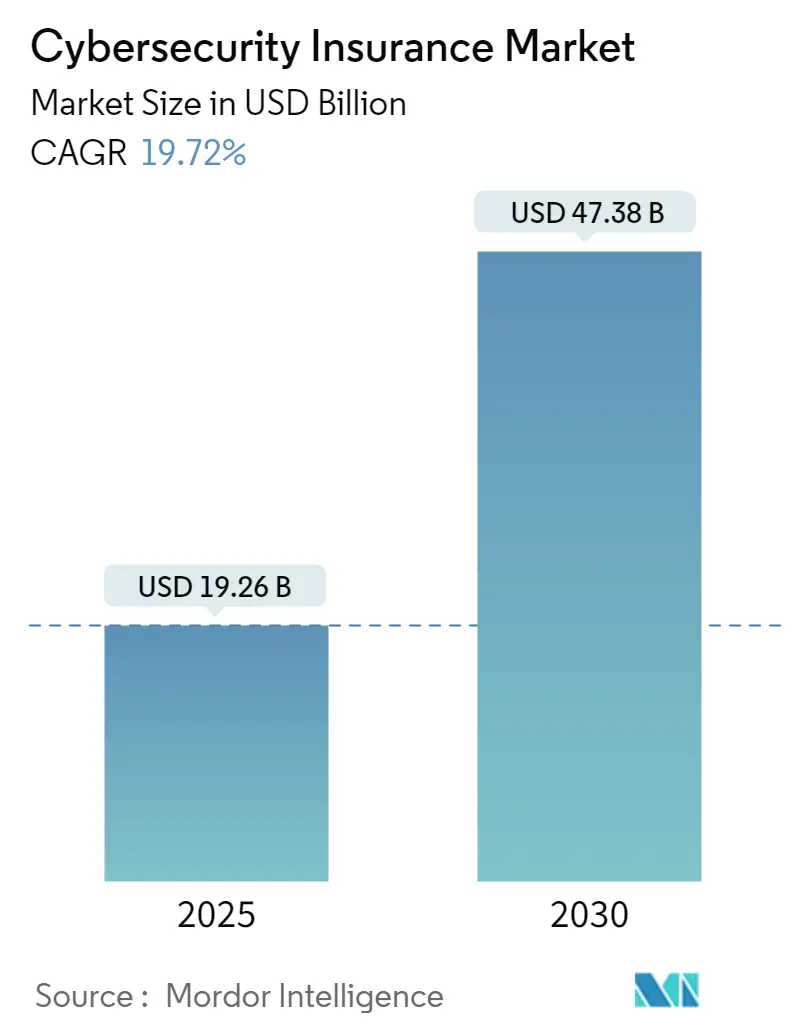
| Study Period | 2019 - 2030 |
| Market Size (2025) | USD 19.26 Billion |
| Market Size (2030) | USD 47.38 Billion |
| CAGR (2025 - 2030) | 19.72 % |
| Fastest Growing Market | Asia Pacific |
| Largest Market | North America |
| Market Concentration | Medium |
Major Players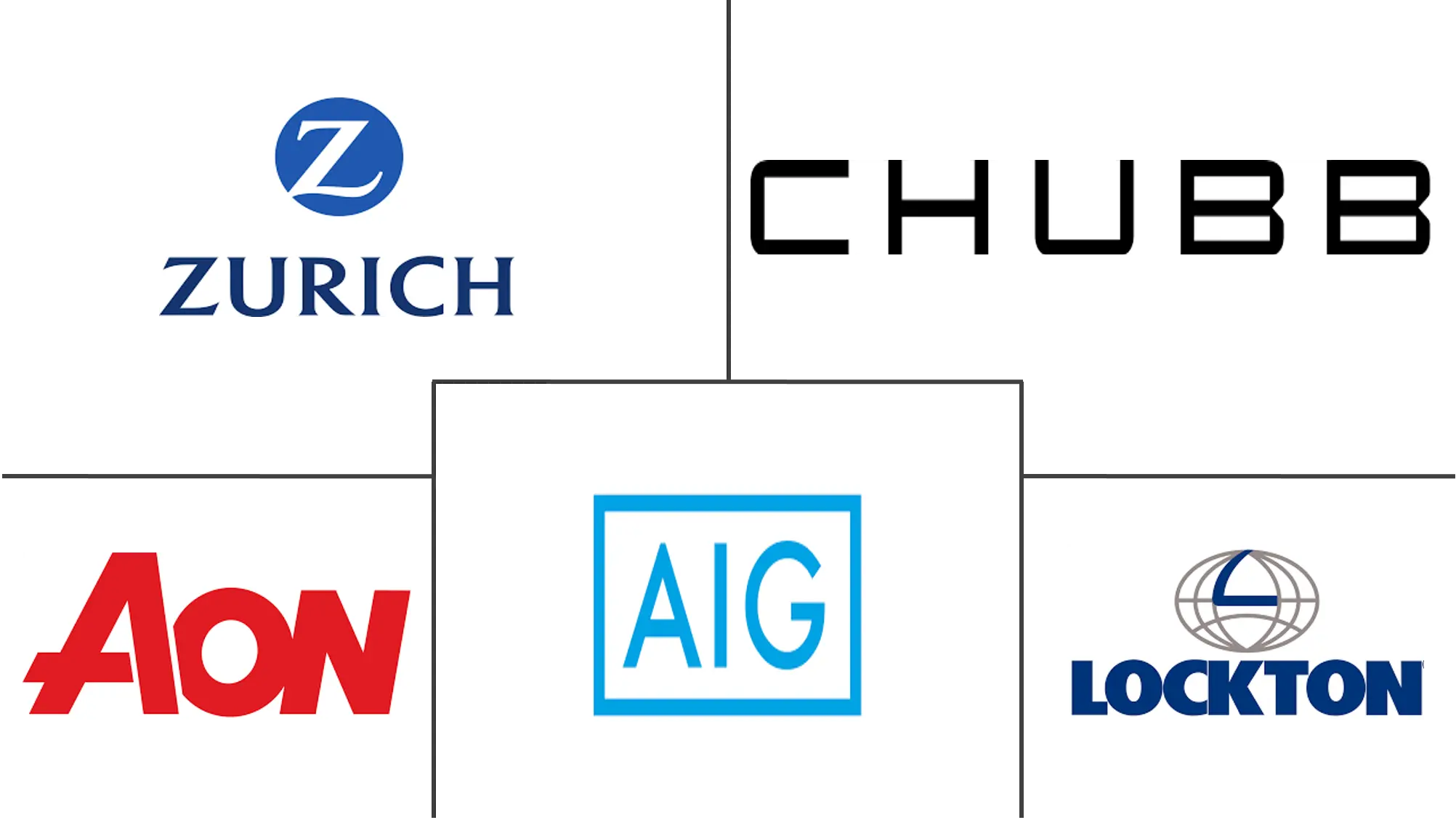
*Disclaimer: Major Players sorted in no particular order |
Cybersecurity Insurance Market Analysis
The Cybersecurity Insurance Market size is estimated at USD 19.26 billion in 2025, and is expected to reach USD 47.38 billion by 2030, at a CAGR of 19.72% during the forecast period (2025-2030).
The cybersecurity insurance landscape is experiencing a fundamental transformation as organizations grapple with increasingly sophisticated cyber threats and evolving technological paradigms. The convergence of IT advances, communication technologies, and smart energy grid implementations is reshaping critical infrastructure and business networks across industries. Insurance providers are adapting their offerings to address the complexities of modern cyber risks, with a particular focus on emerging technologies like artificial intelligence, IoT, and big data. According to IBM's 2022 report, the healthcare sector faces the highest average cost of data breaches at USD 7.3 million, highlighting the critical need for comprehensive cyber risk insurance coverage across industries.
The market is witnessing a significant shift in underwriting approaches as insurers develop more sophisticated risk assessment methodologies. Insurance companies are increasingly incorporating advanced security controls and technologies in their assessments, moving beyond traditional evaluation metrics. The emergence of innovative technologies like microsharding, which fragments data into single-digit bytes before distribution across multiple locations, is revolutionizing data protection strategies. This technological evolution is prompting insurers to reevaluate their coverage parameters and pricing models to better align with contemporary risk profiles.
The industry is experiencing a notable trend toward more comprehensive and specialized coverage options, reflecting the diverse nature of cyber threats. Insurance providers are expanding their service portfolios to include not only incident response and financial protection but also proactive risk management and prevention services. According to the Identity Theft Resource Center (ITRC), data compromises increased by 68% year-on-year during 2021, demonstrating the escalating need for robust cyber liability insurance solutions. This has led to the development of more nuanced policies that address specific industry requirements and risk profiles.
The market is characterized by increasing collaboration between insurers, technology providers, and cybersecurity firms to create more effective risk management solutions. These partnerships are facilitating the development of innovative cyber insurance products that combine traditional coverage with advanced technological solutions. Insurance providers are investing in building internal capabilities by hiring IT professionals and developing proprietary risk assessment frameworks. This evolution is particularly evident in the approach to policy underwriting, where real-time threat intelligence and automated risk assessment tools are becoming standard components of the evaluation process.
Cybersecurity Insurance Market Trends
Increasing Adoption of Cloud-based Services
Cloud computing has become one of the most rapidly growing technologies, fundamentally changing how organizations operate by eliminating traditional IT boundaries and creating new markets. As companies increasingly migrate their operations and sensitive data to cloud environments, they face heightened cybersecurity risks that necessitate specialized cyberattack insurance coverage. The sensitivity level of an organization's data stored in the cloud, and its ability to adequately protect it, plays a key role in determining overall risk exposure, which is driving an increase in the adoption of new technologies like microsharding—a technology that breaks data into tiny fragments before distributing them across multiple locations to reduce the attack surface.
The integration of cloud services has created complex cybersecurity challenges as organizations must now protect data across multiple environments while maintaining centralized visibility and control. Insurance firms have begun partnering directly with major cloud service providers to better understand and assess their customers' risk profiles. For instance, in 2023, several leading insurers have started offering customized cybercrime insurance plans based on how securely their clients configure and maintain their cloud environments. This trend is particularly evident in the financial services sector, where institutions are leveraging cloud capabilities for enhanced customer service while simultaneously seeking comprehensive data protection insurance coverage for their digital infrastructure.
Rising Data Security Breaches
The escalating frequency and sophistication of data security breaches have become a primary driver for cybersecurity insurance adoption across industries. According to recent data from Orange, malware was the most prevalent form of cyberattack in financial and insurance organizations between October 2021 and September 2022, targeting over 40% of organizations globally, followed by network and application anomalies at 23%, and system anomalies at 20%. These statistics highlight the diverse nature of cyber threats that organizations must protect against, leading to increased demand for comprehensive cyber threat insurance coverage that addresses multiple types of cyber risks.
The financial impact of data breaches continues to drive organizations toward cyber protection insurance solutions. Major incidents like the Bitmart crypto platform breach, which resulted in the theft of approximately USD 200 million in assets through a compromised private key, demonstrate the substantial financial risks organizations face. The FBI's Internet Crime Complaint Center has documented a significant surge in cybercrime, with their database accumulating approximately 5.7 million complaints since its establishment. Insurance providers are responding to these trends by developing more sophisticated coverage options that include not only post-breach financial protection but also proactive risk assessment and mitigation services. This evolution in insurance offerings reflects the growing recognition that ransomware insurance must adapt to address both the financial and operational impacts of data breaches.
Segment Analysis: By Organization Size
Large Enterprises Segment in Cybersecurity Insurance Market
Large enterprises continue to dominate the cybersecurity insurance market, holding approximately 63% market share in 2024, driven by their substantial IT infrastructure and higher risk exposure. These organizations face sophisticated cyber threats targeting their extensive digital assets, intellectual property, and customer data. The segment's dominance is reinforced by large enterprises' greater financial capability to invest in comprehensive coverage and their need to protect against potentially devastating financial losses from cyber incidents. Recent high-profile attacks on major corporations have further emphasized the critical importance of cyber liability coverage for large enterprises, leading to increased adoption of more sophisticated and comprehensive coverage options. Additionally, regulatory compliance requirements and stakeholder expectations have pushed large enterprises to maintain robust cyber insurance policies as part of their overall risk management strategy.
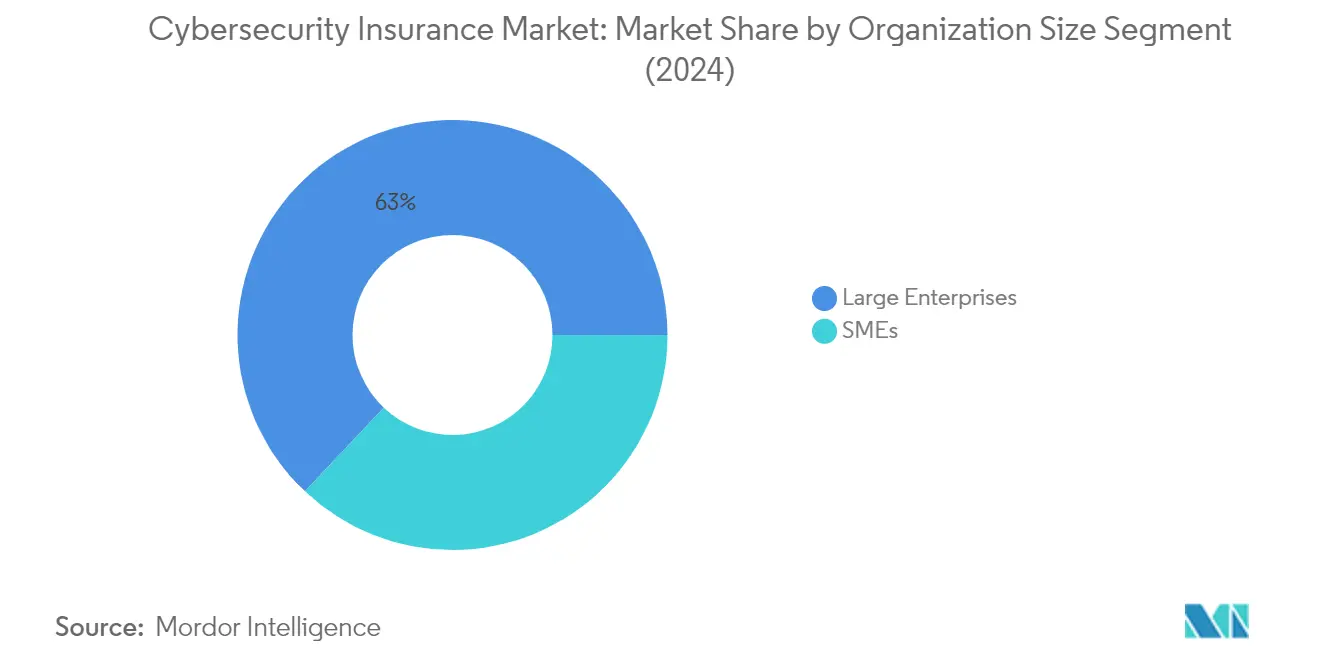
SMEs Segment in Cybersecurity Insurance Market
The Small and Medium Enterprises (SMEs) segment is experiencing the fastest growth in the cybersecurity insurance market, with an expected growth rate of approximately 22% during 2024-2029. This rapid growth is primarily attributed to the increasing recognition among SMEs that they are attractive targets for cybercriminals due to potentially weaker security infrastructure compared to larger enterprises. The segment's growth is further fueled by the rising availability of tailored cyber business insurance products specifically designed for SME needs and budgets. Insurance providers are actively developing more accessible and flexible coverage options, making it easier for smaller businesses to obtain necessary protection. The transition to digital operations, accelerated by recent global events, has also heightened SMEs' awareness of cyber risks, leading to increased adoption of digital insurance policies. Additionally, the growing integration of SMEs into larger supply chains has made cyber insurance a crucial requirement for business partnerships.
Segment Analysis: By End-User Industry
BFSI Segment in Cybersecurity Insurance Market
The Banking, Financial Services, and Insurance (BFSI) sector dominates the cybersecurity insurance market, holding approximately 24% market share in 2024. This significant market position is driven by the sector's critical role in handling sensitive financial data and the increasing sophistication of cyber threats targeting financial institutions. The sector faces multiple challenges, including Trojans, ATM attacks, ransomware, mobile banking vulnerabilities, data breaches, and fiscal breaches. Financial institutions are increasingly recognizing cybersecurity insurance as a vital component of their risk management strategy, particularly due to the stringent regulatory requirements and governance frameworks they must comply with. The sector's dominance is further reinforced by the growing adoption of digital banking services and the increasing integration of fintech solutions, which expand the potential attack surface for cybercriminals.
Manufacturing Segment in Cybersecurity Insurance Market
The manufacturing segment is emerging as the fastest-growing sector in the cybersecurity insurance market, with a projected growth rate of approximately 22% during 2024-2029. This rapid growth is primarily driven by the sector's digital transformation through Industry 4.0 initiatives and the increasing adoption of Industrial Internet of Things (IIoT) technologies. Manufacturing companies are particularly vulnerable due to their extensive dependence on automated systems, interconnected supply chains, and the critical nature of their production data. The sector's cybersecurity insurance needs are expanding due to the growing complexity of cyber threats targeting industrial control systems, the rise in ransomware attacks specifically targeting manufacturing facilities, and the potential for significant business interruption losses in case of a cyber incident. The technology insurance industry is responding by offering specialized policies to address these unique challenges.
Remaining Segments in End-User Industry
The other significant segments in the cybersecurity insurance market include Healthcare, Retail, IT & Telecom, and Other End-user Industries. The healthcare sector remains crucial due to the sensitive nature of patient data and increasing digitalization of medical records. The retail sector's importance is driven by the growth of e-commerce and the need to protect customer payment information. The IT & Telecom sector's demand is fueled by the increasing adoption of cloud services and the need to protect critical communication infrastructure. Other industries, including education, energy, and professional services, contribute to the market's diversity by bringing unique cybersecurity challenges and insurance requirements specific to their operational needs. As these sectors evolve, the digital risk insurance landscape continues to adapt to meet their specific needs.
Cybersecurity Insurance Market Geography Segment Analysis
Cybersecurity Insurance Market in North America
North America represents the most mature and largest cyber insurance market globally, with the United States and Canada being the key contributors. The region's dominance is attributed to the high adoption of digital technologies, stringent regulatory frameworks, and increased awareness about cyber threats among organizations. The presence of major insurance providers and a robust financial services sector further strengthens the market position of North America in the global cybersecurity insurance market landscape.
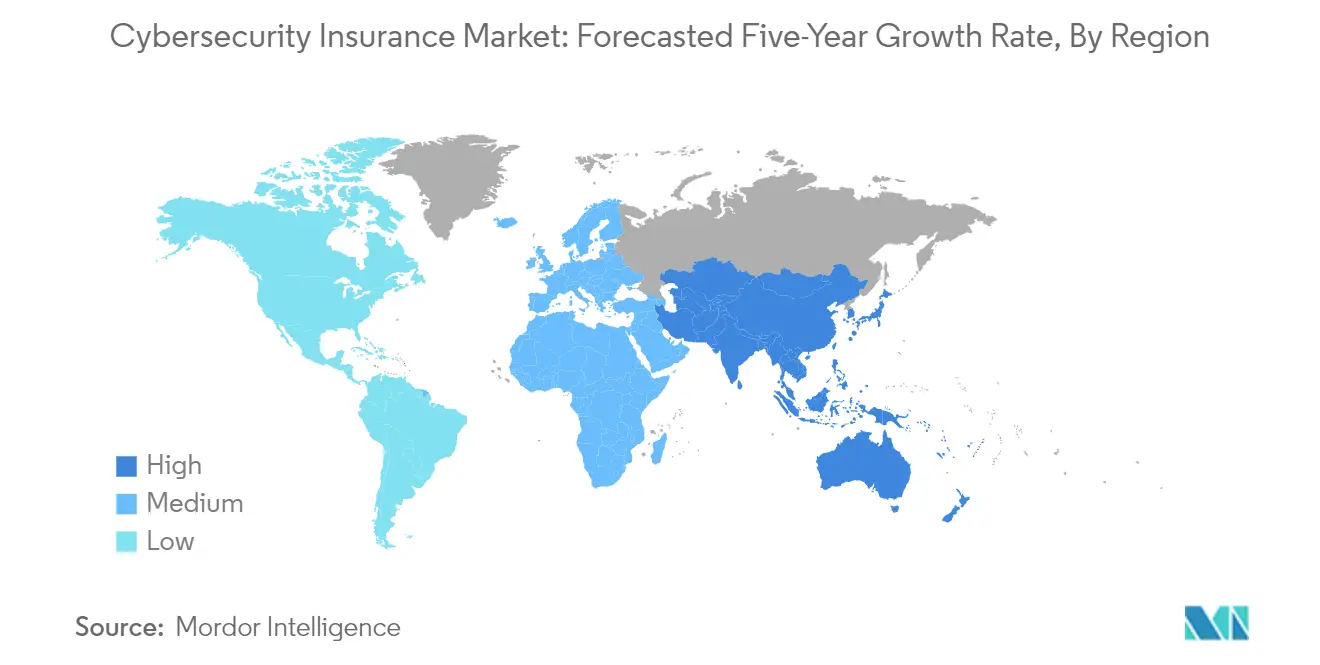
Cybersecurity Insurance Market in the United States
The United States continues to dominate the North American cyber insurance market as the largest country by market size. The country's leadership position is driven by the presence of major technology companies, stringent data protection regulations, and high digital adoption across industries. With approximately 93% share of the North American market in 2024, the United States maintains its position as the primary market for cybersecurity insurance solutions. The country's market is characterized by sophisticated insurance products, innovative coverage options, and a mature understanding of cyber risks across various industry verticals.
Cybersecurity Insurance Market in Canada
Canada emerges as the fastest-growing market in the North American region, demonstrating significant potential for cybersecurity insurance adoption. The country's market is experiencing rapid evolution, driven by increasing digitalization across industries and growing awareness of cyber threats among businesses. With a projected growth rate of approximately 20% during 2024-2029, Canada's market expansion is supported by government initiatives promoting cybersecurity awareness and the increasing adoption of cyber insurance by small and medium enterprises. The country's robust financial sector and growing technology industry continue to drive demand for comprehensive cyber insurance solutions.
Cybersecurity Insurance Market in Europe
Europe represents a significant market for cybersecurity insurance, with Germany, the United Kingdom, and France leading the regional landscape. The implementation of stringent data protection regulations like GDPR has significantly influenced the adoption of cybersecurity insurance across European countries. The region's market is characterized by increasing awareness of cyber risks, growing digital transformation initiatives, and rising incidents of cyber attacks targeting various industries.
Cybersecurity Insurance Market in Germany
Germany stands as the largest cybersecurity insurance market in Europe, driven by its robust industrial base and strong emphasis on data protection. With approximately 30% share of the European market in 2024, Germany's dominance is attributed to its advanced manufacturing sector, strong financial services industry, and high digital adoption rates. The country's market is characterized by comprehensive insurance offerings, a strong regulatory framework, and increasing awareness among businesses about cyber risks.
Cybersecurity Insurance Market in France
France emerges as the fastest-growing market in Europe, showing remarkable potential in the cybersecurity insurance landscape. With a projected growth rate of approximately 25% during 2024-2029, France's market is driven by increasing digital transformation initiatives, growing awareness about cyber threats, and strong government support for cybersecurity measures. The country's focus on protecting critical infrastructure and increasing adoption of cyber insurance by small and medium enterprises continues to drive market growth.
Cybersecurity Insurance Market in Asia-Pacific
The Asia-Pacific region represents a rapidly evolving market for cybersecurity insurance, with China, Japan, India, and Singapore emerging as key markets. The region's digital transformation initiatives, increasing cyber threats, and growing awareness about cyber risks are driving market growth. The diversity of markets in the region presents both opportunities and challenges for insurance providers, with varying levels of market maturity and regulatory frameworks across countries.
Cybersecurity Insurance Market in China
China dominates the Asia-Pacific cyber insurance market, leveraging its vast digital economy and rapid technological advancement. The country's market leadership is driven by increasing digitalization across industries, growing cyber threats, and strong government support for cybersecurity initiatives. The presence of large enterprises, an expanding financial sector, and increasing awareness about cyber risks continue to drive market growth in China.
Cybersecurity Insurance Market in India
India emerges as the fastest-growing market in the Asia-Pacific region, demonstrating significant potential in the cybersecurity insurance landscape. The country's market growth is driven by rapid digital transformation, increasing cyber threats, and growing awareness among businesses about the importance of cyber insurance. The government's push for digital initiatives, an expanding IT sector, and rising adoption of cyber insurance by small and medium enterprises contribute to the market's rapid expansion.
Cybersecurity Insurance Market in Rest of the World
The Rest of the World region, encompassing Latin America, the Middle East, and Africa, represents an emerging market for cybersecurity insurance with significant growth potential. These regions are witnessing increasing adoption of digital technologies, rising cyber threats, and growing awareness about the importance of cyber insurance. The market is characterized by varying levels of digital maturity, regulatory frameworks, and cyber insurance adoption across different countries. Brazil emerges as the largest market in this region, while Mexico demonstrates the fastest growth rate, driven by increasing digitalization and rising cyber threats across various sectors.
Cybersecurity Insurance Industry Overview
Top Companies in Cybersecurity Insurance Market
The cyber insurance industry features prominent players like AXA, American International Group, Berkshire Hathaway, Zurich Insurance, Chubb Corporation, and Allianz Global, who are driving innovation through comprehensive digital solutions. Companies are increasingly focusing on developing integrated cyber risk assessment platforms, automated underwriting capabilities, and real-time threat monitoring systems to enhance their service offerings. Strategic partnerships with cybersecurity insurance companies and technology providers have become crucial for expanding product portfolios and improving risk assessment capabilities. Market leaders are investing heavily in artificial intelligence and machine learning technologies to strengthen their predictive analytics and claims processing efficiency. Additionally, insurers are expanding their geographical presence through strategic acquisitions and partnerships while simultaneously developing specialized products for different industry verticals and business sizes.
Market Dominated by Global Insurance Conglomerates
The cybersecurity insurance market structure is characterized by the strong presence of established global insurance conglomerates who leverage their extensive distribution networks and financial strength to maintain market leadership. These major players benefit from their ability to offer bundled insurance products, strong underwriting capabilities, and established relationships with reinsurance providers. The market shows moderate consolidation, with larger insurers actively acquiring specialized cybersecurity firms and insurtech startups to enhance their technical capabilities and market reach.
The competitive dynamics are evolving with the emergence of specialized cyber insurance providers and insurtech companies who are challenging traditional insurers through innovative product offerings and digital-first approaches. Market participants are increasingly focusing on developing ecosystem partnerships with cybersecurity vendors, technology providers, and incident response specialists to create comprehensive risk management solutions. The industry is witnessing a trend toward vertical integration as insurers build in-house technical expertise through strategic hiring and acquisition of cybersecurity assessment platforms.
Innovation and Expertise Drive Market Success
Success in the cyber insurance industry increasingly depends on insurers' ability to combine traditional underwriting expertise with advanced technological capabilities. Market leaders are focusing on developing sophisticated risk assessment models, implementing automated claims processing systems, and building comprehensive incident response networks. Companies are also investing in developing specialized products for different industry verticals while simultaneously working to simplify policy structures and improve transparency in coverage terms. The ability to provide value-added services such as preventive risk assessment, incident response planning, and post-breach support has become crucial for maintaining a competitive advantage.
For new entrants and smaller players, success lies in identifying and serving underserved market segments, particularly among small and medium enterprises. Companies need to focus on developing innovative distribution channels, forming strategic partnerships with technology providers, and creating specialized products for specific industry verticals. The regulatory landscape is becoming increasingly complex, requiring insurers to maintain robust compliance frameworks while adapting to evolving cybersecurity standards. Market participants must also address the challenge of balancing comprehensive coverage with sustainable pricing models while managing accumulation risk through effective portfolio diversification strategies. This cyber insurance market analysis underscores the importance of these strategic initiatives.
Cybersecurity Insurance Market Leaders
-
American International Group Inc.
-
Zurich Insurance Co. Ltd
-
The Chubb Corporation
-
Aon PLC
-
Lockton Companies Inc.
- *Disclaimer: Major Players sorted in no particular order
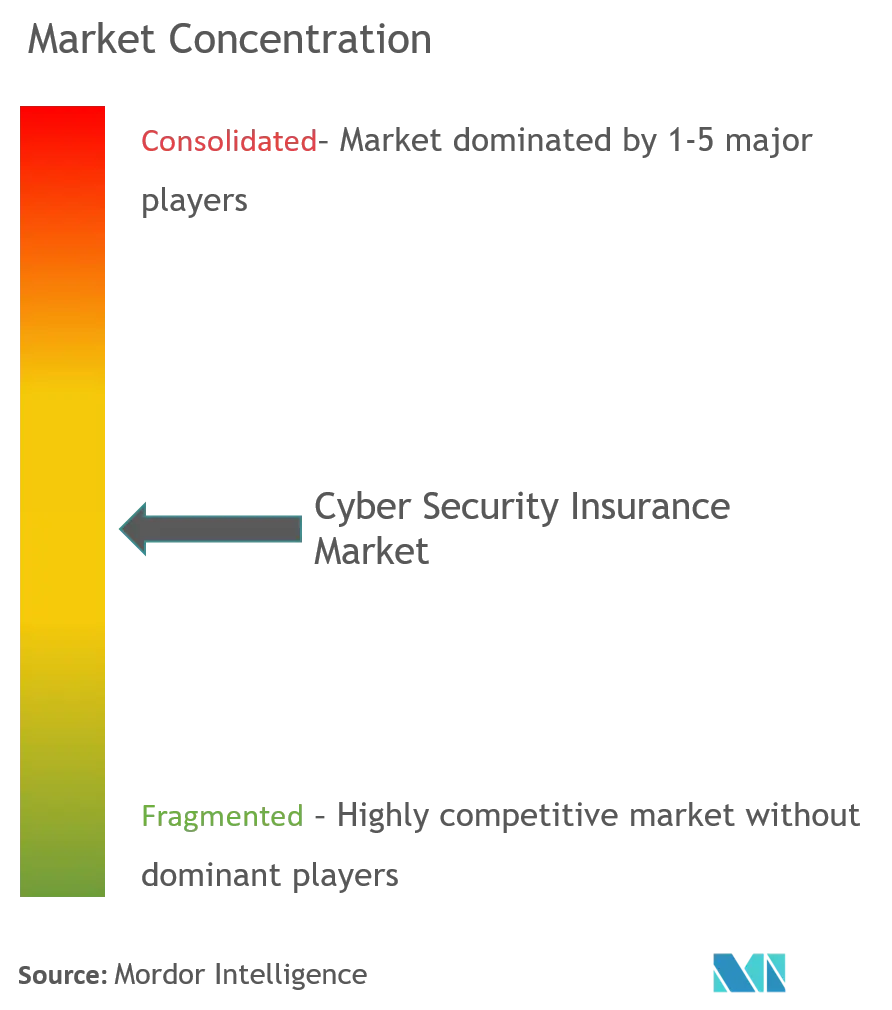
Cybersecurity Insurance Market News
- July 2024: QBE Insurance, a global insurer with operations in 27 countries, introduced QCyberProtect. This new product is a comprehensive cyber policy designed to enhance cyber resilience for a wide range of clients worldwide. QCyberProtect offers tailored coverage for losses arising from both current and emerging cyber risks. These risks include, but are not limited to, network security breaches, privacy liabilities, business interruptions in both IT and non-IT sectors, and reputational damage.
- Janauary 2024: WTW, a global brokerage firm, has introduced a cyber solution specifically designed for small and medium-sized enterprises (SMEs) in North America. This product targets businesses, including startups and pre-revenue entities, with annual revenues not exceeding USD 50 million. WTW's tailored solution allows these SMEs to effortlessly obtain competitive insurance quotes through self-service platforms.
Cybersecurity Insurance Market Report - Table of Contents
1. INTRODUCTION
- 1.1 Study Assumptions and Market Definition
- 1.2 Scope of the Study
2. RESEARCH METHODOLOGY
3. EXECUTIVE SUMMARY
4. MARKET INSIGHTS
- 4.1 Market Overview
- 4.2 Industry Value Chain Analysis
-
4.3 Industry Attractiveness - Porter's Five Forces Analysis
- 4.3.1 Threat of New Entrants
- 4.3.2 Bargaining Power of Buyers
- 4.3.3 Bargaining Power of Suppliers
- 4.3.4 Threat of Substitute Products
- 4.3.5 Intensity of Competitive Rivalry
- 4.4 Industry Guidelines and Policies
- 4.5 Assessment of the Impact of COVID-19 on the Market
5. MARKET DYNAMICS
-
5.1 Market Drivers
- 5.1.1 Increasing Adoption of Cloud-based Services
- 5.1.2 Rising Data Security Breaches
-
5.2 Market Restraints
- 5.2.1 Difficulties in Implementing Cyber Insurance and High Costs
6. MARKET SEGMENTATION
-
6.1 Organization Size
- 6.1.1 Small and Medium Enterprises (SMEs)
- 6.1.2 Large Enterprises
-
6.2 End-user Industry
- 6.2.1 Healthcare
- 6.2.2 Retail
- 6.2.3 BFSI
- 6.2.4 IT and Telecom
- 6.2.5 Manufacturing
- 6.2.6 Other End-user Industries
-
6.3 Geography
- 6.3.1 North America
- 6.3.1.1 United States
- 6.3.1.2 Canada
- 6.3.2 Europe
- 6.3.2.1 Germany
- 6.3.2.2 United Kingdom
- 6.3.2.3 France
- 6.3.3 Asia
- 6.3.3.1 India
- 6.3.3.2 China
- 6.3.3.3 Japan
- 6.3.3.4 Singapore
- 6.3.3.5 Australia and New Zealand
- 6.3.4 Latin America
- 6.3.5 Middle East and Africa
7. COMPETITIVE LANDSCAPE
-
7.1 Company Profiles
- 7.1.1 American International Group Inc.
- 7.1.2 Zurich Insurance Co. Ltd
- 7.1.3 Aon PLC
- 7.1.4 Lockton Companies Inc.
- 7.1.5 The Chubb Corporation
- 7.1.6 AXA XL
- 7.1.7 Berkshire Hathaway Inc.
- 7.1.8 Insureon
- 7.1.9 Security Scorecard Inc.
- 7.1.10 Allianz Global Corporate & Specialty (AGCS)
- 7.1.11 Munich Re Group
- *List Not Exhaustive
8. INVESTMENT ANALYSIS
9. MARKET OPPORTUNITIES AND FUTURE TRENDS
Cybersecurity Insurance Industry Segmentation
Cybersecurity insurance is a contract that an individual or entity can purchase to help reduce the financial risks associated with an online business. The insurance policy transfers some of the risks to the insurer in exchange for a monthly or quarterly fee. Many companies purchase cybersecurity insurance policies to cover extra expenditures that could result from the physical destruction or theft of digital assets. Such spending typically includes the cost of notifying customers that a security breach has been incurred, as well as the cost of regulatory compliance fines.
The cybersecurity insurance market is segmented by size of organization (small and medium enterprises (SMEs) and large enterprises), end-user industry (healthcare, retail, BFSI, IT and telecom, and manufacturing), and geography (North America, Europe, Asia Pacific, Rest of the World).
The market sizes and forecasts are provided in terms of value (USD) for all the above segments.
| Organization Size | Small and Medium Enterprises (SMEs) | ||
| Large Enterprises | |||
| End-user Industry | Healthcare | ||
| Retail | |||
| BFSI | |||
| IT and Telecom | |||
| Manufacturing | |||
| Other End-user Industries | |||
| Geography | North America | United States | |
| Canada | |||
| Europe | Germany | ||
| United Kingdom | |||
| France | |||
| Asia | India | ||
| China | |||
| Japan | |||
| Singapore | |||
| Australia and New Zealand | |||
| Latin America | |||
| Middle East and Africa | |||
Cybersecurity Insurance Market Research FAQs
How big is the Cybersecurity Insurance Market?
The Cybersecurity Insurance Market size is expected to reach USD 19.26 billion in 2025 and grow at a CAGR of 19.72% to reach USD 47.38 billion by 2030.
What is the current Cybersecurity Insurance Market size?
In 2025, the Cybersecurity Insurance Market size is expected to reach USD 19.26 billion.
Who are the key players in Cybersecurity Insurance Market?
American International Group Inc., Zurich Insurance Co. Ltd, The Chubb Corporation, Aon PLC and Lockton Companies Inc. are the major companies operating in the Cybersecurity Insurance Market.
Which is the fastest growing region in Cybersecurity Insurance Market?
Asia Pacific is estimated to grow at the highest CAGR over the forecast period (2025-2030).
Which region has the biggest share in Cybersecurity Insurance Market?
In 2025, the North America accounts for the largest market share in Cybersecurity Insurance Market.
What years does this Cybersecurity Insurance Market cover, and what was the market size in 2024?
In 2024, the Cybersecurity Insurance Market size was estimated at USD 15.46 billion. The report covers the Cybersecurity Insurance Market historical market size for years: 2019, 2020, 2021, 2022, 2023 and 2024. The report also forecasts the Cybersecurity Insurance Market size for years: 2025, 2026, 2027, 2028, 2029 and 2030.
Our Best Selling Reports
Cybersecurity Insurance Market Research
Mordor Intelligence delivers a comprehensive analysis of the cyber insurance market. We leverage extensive expertise in the technology insurance industry research and consulting. Our latest report examines the evolving landscape of cybersecurity insurance. It covers crucial areas such as cyber liability coverage, data breach insurance, and ransomware insurance. The analysis provides detailed insights into cyber risk insurance solutions, cyber attack insurance developments, and emerging trends in digital insurance services.
Stakeholders seeking to understand the size of cyber insurance market and its trajectory will find valuable insights in our easily downloadable report PDF. The document offers a detailed cyber insurance market analysis, including cyber insurance market forecast data, cyber insurance market trends, and growth projections. Our research covers various segments, including cyber crime insurance, cyber protection insurance, and network security insurance. This provides stakeholders with actionable intelligence for strategic decision-making. The report examines cyber business insurance dynamics, information security insurance developments, and digital risk insurance opportunities across global markets.




